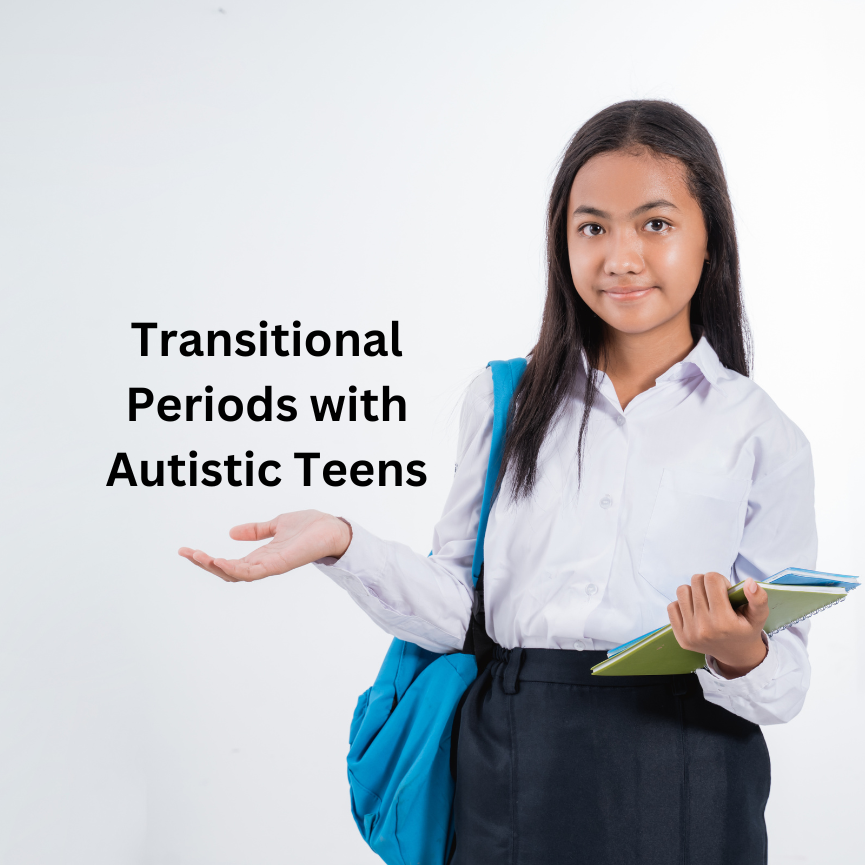
- May 09, 2024
- 81 Views
- 0 Comments
Navigating Transitional Periods With Autistic Teens
Empowering Autistic Teens: Strategies for Successful Transitional Periods
Navigating the transitional periods of adolescence can be challenging for any teenager, but for those on the autism spectrum, these transitions can bring about unique hurdles and considerations. As parents, caregivers, and educators, it's crucial to provide the right support during these times to ensure the well-being and success of autistic teens. In this comprehensive guide, we will explore strategies, tips, and insights for supporting autistic teens during transitional periods.
Understanding the Challenges
Autistic individuals often experience difficulties with change and unpredictability. The transitional periods in a teenager's life, such as moving from middle school to high school or preparing for post-secondary education and adulthood, can be overwhelming. Here are some challenges that autistic teens might face:
- Social Interactions: Adolescence is a time of increased social interactions, which can be stressful for autistic teens who struggle with social cues, communication, and making friends.
- Routine Disruption: Transitions can disrupt established routines that provide comfort and predictability for autistic individuals, leading to anxiety and distress.
- Sensory Sensitivities: Changes in environment, noise levels, and sensory stimuli can be overwhelming for autistic teens, impacting their ability to focus and cope.
- Executive Functioning: Planning, organizing, and managing time are skills that might be challenging for autistic teens, making the transition to new academic or life responsibilities difficult.
Strategies for Smooth Transitions
Early Preparation:
Preparing for transitions well in advance is a cornerstone of helping autistic teens navigate change successfully. This involves taking proactive steps to introduce upcoming changes in their routine. For instance:
- Familiarization: Arrange visits to the new school or environment ahead of time. This allows the autistic teen to become acquainted with the surroundings and reduce the uncertainty associated with new places.
- Meetings: Facilitate meetings with future teachers, mentors, and school staff. Establishing these connections can ease anxiety by putting faces to names and building a sense of familiarity.
- Gradual Introduction: Introduce changes in increments. For example, if transitioning to a new school, gradually expose the teen to the new environment, starting with short visits and gradually extending the duration.
Visual Supports:
Visual supports play a crucial role in providing clarity and predictability for autistic teens. These aids translate abstract concepts into concrete visuals, making the transition more understandable and manageable. Some ways to implement visual supports include:
- Schedules: Create visual schedules outlining daily activities, classes, and routines. Having a visual representation of their day helps the teen anticipate what's coming next.
- Social Stories: Develop social stories that explain upcoming changes in a structured narrative. These stories can include details about the transition, what to expect, and how to cope with any challenges that might arise.
- Visual Timetables: Utilize visual timetables for larger time frames, such as the week or month. These timetables can highlight key events, deadlines, and important milestones during the transition period.
Communication:
Maintaining open and honest communication with the autistic teen is fundamental for their emotional well-being and successful navigation of transitions. Consider these communication strategies:
- Listening and Validation: Create a safe space for the teen to express their thoughts and concerns. Listen attentively and validate their feelings, letting them know that their emotions are understood and respected.
- Addressing Questions: Encourage the teen to ask questions about the upcoming changes. Address their queries with clear, accurate information, helping to dispel any misconceptions or anxieties.
- Collaborative Planning: Involve the teen in planning the transition whenever possible. Their input can contribute to a smoother process and help them feel more in control of the situation.
Individualized Plans:
Recognizing that each autistic teen is unique, the development of an Individualized Education Plan (IEP) or a tailored transition plan is crucial. This strategy involves:
- Assessment: Collaborate with educators, professionals, and parents to assess the teen's strengths, challenges, and specific needs. This assessment forms the basis for creating a customized plan.
- Accommodations: Outline the accommodations and support mechanisms that will be in place during the transition. These accommodations might include extended deadlines, preferential seating, or additional communication support.
- Goals: Set achievable goals for the teen to work towards during the transition. These goals could encompass academic, social, and emotional milestones, providing a sense of purpose and accomplishment.
Social Skills Training:
Social skills training equips autistic teens with the tools they need to engage effectively with their peers and navigate social interactions. Some aspects of this training include:
- Communication Techniques: Teach communication skills, including active listening, making eye contact, and using appropriate body language.
- Friendship Building: Provide guidance on initiating and maintaining friendships. Role-playing scenarios can help the teen practice social interactions in a controlled setting.
- Understanding Social Cues: Break down social cues and unwritten rules into concrete explanations. This helps the teen interpret social situations more accurately.
Sensory-Friendly Environment:
Creating a sensory-friendly environment is essential to support autistic teens during transitions, as sensory sensitivities can significantly impact their well-being. Here's how to establish such an environment:
- Designated Spaces: Set up designated sensory-friendly spaces at home and school where the teen can retreat to when feeling overwhelmed. These spaces should be quiet, comfortable, and equipped with sensory tools.
- Sensory Considerations: Factor in sensory sensitivities when planning the physical environment. This might involve adjusting lighting, noise levels, and sensory stimuli to ensure comfort and reduce anxiety.
Gradual Exposure:
Gradual exposure to new situations and environments can help autistic teens adapt to change in a manageable way. Consider the following steps:
- Step-by-Step Approach: Introduce the teen to new experiences gradually, starting with less challenging scenarios and progressively moving towards more complex situations.
- Positive Reinforcement: Provide positive reinforcement and encouragement during each phase of exposure. Recognize their efforts and celebrate their achievements, no matter how small.
- Accompanying Support: Offer support during exposure experiences. A trusted adult or peer mentor can provide reassurance and guidance, helping to alleviate anxiety.
Empowerment:
Empowering autistic teens to take an active role in their transitions fosters independence and self-confidence. Empowerment strategies include:
- Self-Advocacy: Teach the teen to express their needs, preferences, and concerns to teachers, mentors, and peers. This skill promotes a sense of agency and ensures their unique requirements are met.
- Decision-Making: Involve the teen in decision-making processes related to their transition. Whether it's choosing extracurricular activities or selecting classes, their involvement enhances their ownership of the transition.
- Strength Recognition: Highlight the teen's strengths and capabilities. This positive reinforcement bolsters their self-esteem and self-perception as they approach new challenges.
Transitioning to Adulthood
As autistic teens approach adulthood, the transitions become even more complex. Here are some considerations for this phase:
- Vocational Planning: Explore vocational training and employment opportunities that align with the individual's strengths and interests. Seek guidance from career counselors experienced in working with neurodiverse individuals.
- Independent Living Skills: Equip autistic teens with essential life skills such as budgeting, cooking, and using public transportation. These skills are crucial for their independence.
- Continued Support: Ensure that support systems are in place even after high school. Colleges, universities, and workplaces should be informed about the individual's needs and provided with necessary accommodations.
Supporting autistic teens during transitional periods requires patience, understanding, and a proactive approach. By recognizing the challenges they face and implementing tailored strategies, we can empower them to navigate these transitions with confidence. By fostering an inclusive and supportive environment, we enable autistic teens to embrace their uniqueness and reach their full potential as they journey into adulthood.



Comments - 0 comments till now